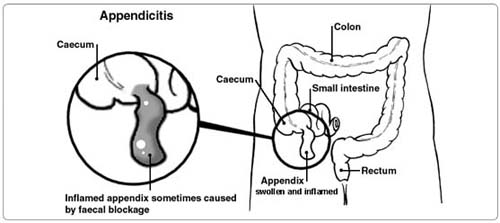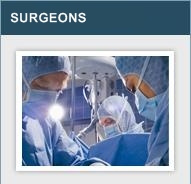What is it?
The appendix is an out-pouching of the bowel about the size of your little finger. It lies low down in the right side of your tummy. It is of no practical use in humans, but is important in grass-eating animals. Quite commonly the appendix gets swollen and causes pain. If left it can end up by bursting inside the tummy causing serious infection and illness. Sometimes the appendix scars up from past infections and causes pains (grumbling appendix). A diseased appendix needs to be taken out. Sometimes in patients with these signs, the appendix is normal when it is taken out. In cases of doubt, it is safer to remove the appendix than to risk the problem of leaving a diseased appendix inside.

The Operation
The operation is called an appendicectomy. You will have a general anaesthetic, and will be asleep for the whole operation. The appendix may be taken out by the keyhole method, or by the open method. The doctors will discuss this with you. If taking out your appendix using the keyhole method is not best for you, the open method is performed. This means making a cut in the skin and muscle over the appendix. The appendix is cut off and the hole in the bowel is closed. The wound is then stitched up. Alternatively, the key-hole method means making 3 or more tiny openings less than an inch across in the lower part of your tummy. The appendix is freed and taken out through one of the openings. The openings are then closed up. Sometimes the appendix is so stuck or swollen that it has to be taken out using the open method. The surgeon can only tell this at the time of the operation. Usually after 2 to 3 days from the time of the keyhole operation, or 3 to 5 days from the time of open operation you will be fit enough to leave hospital provided there is someone to look after you.
Any Alternatives
If you leave things as they are, they will probably get much worse. You can become very ill with infection and bowel problems. Antibiotics on their own are not helpful. There is no x-ray or laser treatment.
Before the operation
You may have come to hospital as an emergency. If not, stop smoking and try to get your weight down if you are overweight. If you know that you have problems with your blood pressure, your heart, or your lungs, ask your family doctor to check that these are under control. Check the hospital's advice about taking the pill or hormone replacement therapy (HRT). Check you have a relative or friend who can come with you to hospital, take you home, and look after you for the first week after the operation. Sort out any tablets, medicines, inhalers that you are using. Keep them in their original boxes and packets. Bring them to hospital with you. On the ward, you may be checked for past illnesses and may have special tests, ready for the operation. Please tell the nurses of any allergies to tablets, medicines or dressings. You will have the operation explained to you and will be asked to fill in an operation consent form. Many hospitals now run special preadmission clinics, where you visit for an hour or two, a few weeks or so before the operation for these checks.
After - In Hospital
You may be given oxygen from a face mask for a few hours if you have had chest problems in the past. You may have a fine plastic tube running down the back of your nose to drain your stomach for a few days. You may have a fine tube in an arm vein connected to a plastic bottle to give you salt, sugar and water until the bowel recovers from the operation. You may have a drainage tube coming out of your skin near the wound to get rid of secretions. There is some discomfort on moving rather than severe pain. You will be given injections or tablets to control this as required. Ask for more if the pain is still unpleasant. A general anaesthetic will make you slow, clumsy and forgetful for about 24 hours. Do not make important decisions during that time. You will be expected to get out of bed the day after operation despite the discomfort. You will not do the wound any harm, and the exercise is very helpful for you. The second day after operation you should be able to spend most of your time out of bed and in reasonable comfort. By the end of one week the wound should be virtually pain-free. It is important that you pass urine and empty your bladder within 6-12 hours of the operation. If you cannot pass urine let the nurses know. Any wounds will have a dressing which may show some staining with old blood in the first 24 hours. There may be some purple bruising around a wound, which spreads downward by gravity and fades to a yellow colour after 2 to 3 days. It is not important.
There may be some swelling of the surrounding skin which also improves in 2 to 3 days. After 7 to 10 days, slight crusts on a wound will fall off. Occasionally minor matchhead sized blebs form on the wound line. These settle down after discharging a blob of yellow fluid for a day or so. Any wound drain is usually taken out in 3 or 4 days. If you have had the keyhole operation, the dressings will be changed as necessary. You can take the dressing off after 48 hours. There is no need for a dressing after this unless the wound is painful when rubbed by clothing. There may be stitches or clips in the skin. You can wash the wound area as soon as the dressing has been removed. Soap and warm tap water are entirely adequate. Salted water is not necessary. You can shower or take a bath as often as you want. Some hospitals arrange a check up about one month after you leave hospital. Others leave check-ups to the General Practitioner. The nurses will advise about sick notes, certificates etc. Arrnagments will be made for removal of any stitches or clips.
After - At Home
You are likely to feel tired and need rests 2 or 3 times a day for 2 weeks or more. You will gradually improve so that after a month you should be fit enough for your normal activities. At first discomfort in the wound will prevent you from harming yourself by too heavy lifting. After one month you can lift whatever you like. There is no value in attempting to speed the recovery of the wound by special exercises before the month is out. You can drive as soon as you can make an emergency stop without discomfort in the wound, i.e. after about 10 days. You can restart sexual relations within a week or two, when the wound is comfortable enough. You should be able to return to a light job after about 3 weeks and any heavy job within 6 weeks.
Possible Complications
Complications are sometimes seen mainly because of infection from the appendix. You will be given antibiotics to counter this. If you think that all is not well, please ask the nurses or doctors. Bruising and swelling may be troublesome. The swelling make take 4 to 6 weeks to settle down. Your recovery can be slower if the appendix has burst by the time of operation. Occasionally there is a discharge from the wound as infection clears itself. Rarely infection gathers inside the tummy and needs to be drained. Aches and twinges may be felt in the wound for up to 6 months.





